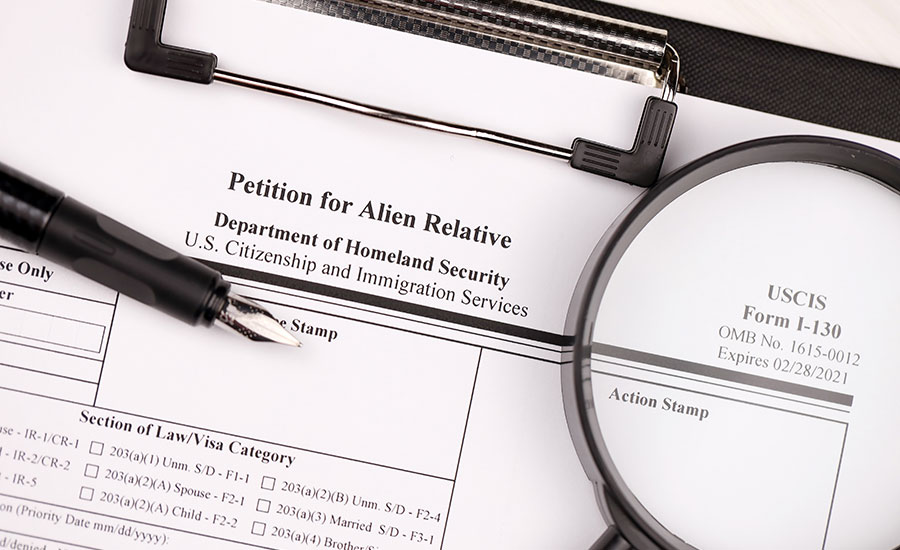

Form I-751: Key Takeaways
- Form I-751 is used to remove conditions from your 2-year marriage-based Green Card and transition to a 10-year permanent Green Card
- You are required to submit the form with the U.S. Citizenship and Immigration Services (USCIS) within 90 days before your conditional Green Card expires
- The filing fee for Form I-751 is $750
- The process includes several key steps such as completing the form, collecting supporting documents, and sending it to the correct address
- USCIS typically takes 24 to 30 months to process Form I-751
In the fiscal year 2023, USCIS denied 5,531 out of 119,672 Form I-751 petitions. This serves as a reminder that even simple-looking processes can go wrong.
We’ll break down:
- Form I-751 use
- When to file it
- What steps the process includes
- The cost and processing time for Form I-751
Form I-751 Explained
Form I-751, Petition to Remove Conditions on Residence, is used to remove conditions on your two-year conditional Green Card that you received through marriage to a U.S. citizen or lawful permanent resident.
Removing conditions allows you to:
- Apply for a ten-year-valid Green Card.
- Achieve more stability in terms of your immigration status.
- Access more Green Card benefits such as applying for naturalization, provided you meet certain additional requirements.
When To File Form I-751
It’s crucial to file Form I-751 during the 90-day window before your conditional Green Card expires.
How to calculate the right time?
Imagine your conditional Green Card was issued on August 1, 2023. This means you must file Form I-751 between May 3, 2025, and August 1, 2025.
Filing before the 90-day window will result in USCIS rejecting your petition.
Filing too late could have serious consequences, including the risk of losing your legal status and facing deportation.
To stay on the safe side and make sure you don’t file too early or too late, use the USCIS filing date calculator.

Form I-751: Process
Each step, from gathering the right documents to mailing Form I-751 on time, plays a critical role in keeping your immigration status secure.
1. Find The Latest Form
- Go to the USCIS website and look for the Form I-751 page.
- Download the most current version of the form.
- Review the instructions to understand eligibility, required documents, and filing procedures.
2. Determine How You Will File
There are two ways to file Form I-751: jointly with your spouse or alone using a waiver.
- You must file jointly, if you’re still married to the same U.S. citizen or permanent resident spouse through whom you received your Green Card.
- You can file on your own, if your spouse has died, the marriage ended in divorce, or you or your child were abused by your spouse. Note that you must provide documentation to support your reason for not filing the petition together.
3. Gather Supporting Documents
To show your marriage was real you’ll need to include evidence like shared bills, photos as a couple, birth certificates of children, or joint tax returns — anything that reflects your life together.
4. Complete & Sign Form I-751
Fill out the form carefully and double-check for missed fields, misspelled names, or errors.
Missing or incorrect information can delay processing or make USCIS request additional evidence.
5. Pay The Fee
Use a check, money order, or credit card (along with Form G-1450) to pay the filing fee (see the amount in the section below).
6. File Your Petition
Currently, you cannot file Form I-751 online.
Mail your completed Form I-751, required documents, and payment to the correct USCIS lockbox address depending on the area where you live.
Mailing Form I-751 to the wrong address can:
- Delay your case.
- Lead to rejection.
- Make you miss your 90-day filing window, putting your immigration status at risk.
7. Wait For Your Receipt Notice
USCIS will send Form I- 797, Notice of Action, to confirm they received your petition and documents.
Form I-797 will also extend your conditional Green Card by 48 months covering the time when your petition is being reviewed.
8. Attend A Biometrics Appointment
You’ll receive an appointment notice to appear at a local Application Support Center (ASC) where officials will take your fingerprints and photo for background checks.
9. Wait For USCIS Decision
Once USCIS receives everything, they’ll take a look at your documents to decide if more info is needed.
You may receive:
- Approval without going for an interview, if your petition has strong supporting documents.
- A request for additional evidence (RFE), if USCIS needs more information.
- An interview notice, if USCIS wants to verify details of your case. The notice will have the date, time, location, and a list of documents you must bring.
The interview will include questions about your marital relationship. If your and your partner’s answers are inconsistent, USCIS may conduct a Stokes interview, where you and your spouse will be asked questions separately to confirm your marriage is bona fide.
The process of removing conditions may be challenging, and it’s recommended that you work with an immigration attorney to increase your chances of a successful outcome.

Form I-751: Cost
The fee for filing Form I-751 is $750.
You will not have to pay a fee if you filed a waiver based on battery or extreme cruelty.
Form I-751: Processing Time
It takes USCIS between 24 and 30 months to review your Form I-751. This timeline is based on processing 80% of cases in the past 180 days.
The cases are processed in the order they are received and can take longer or shorter depending on your unique circumstances.
Need Help With Form I-751? Spar & Bernstein Can Help
Are you feeling stressed out as the expiration date on your conditional Green Card is fast approaching?
The knowledgeable and compassionate attorneys at Spar & Bernstein can take that stress off your shoulders by handling the process for you.
With over 60 years of experience in immigration law for businesses and individuals, we have stood by our clients every step of the way and helped them achieve their dream of settling down and working in the United States.
We will:
- Evaluate your eligibility and timeline.
- Help you collect supporting documents to prove your marriage is real.
- File your petition accurately and on time.
- Represent you if USCIS requests additional evidence or an interview.
Form I-751: FAQs
What happens if I miss the 90-day filing window?
If you don’t file Form I-751 within the 90-day window, you may be deported from the U.S. Talk to our experienced team at Spar & Bernstein. We’ll explain your options and check if you can file the form along with documentation explaining the delay.
Can I file Form I-751 after divorce?
Yes, you can file Form I-751 after a divorce, but you’ll need to prove that the marriage was entered in good faith.
Will I get a new Green Card if USCIS approves my Form I-751?
Yes, if your petition is approved, you will receive a 10-year permanent Green Card.





